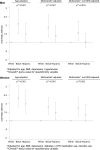Are racial/ethnic disparities in the prevalence of nocturia due to socioeconomic status? Results of the BACH survey
- PMID: 19233415
- PMCID: PMC2770809
- DOI: 10.1016/j.juro.2008.11.103
Are racial/ethnic disparities in the prevalence of nocturia due to socioeconomic status? Results of the BACH survey
Abstract
Purpose: Racial/ethnic disparities in nocturia prevalence have been reported previously. We estimated nocturia prevalence rates by race/ethnicity and determined the contribution of socioeconomic status to potential differences by race/ethnicity.
Materials and methods: The Boston Area Community Health Survey used a multistage stratified design to recruit a random sample of 5,501 adults, including 2,301 men and 3,200 women, who were 30 to 79 years old. Nocturia was defined as voiding more than once per night in the last week or voiding more than once per night fairly often, usually or almost always in the last month. Self-reported race/ethnicity was defined as black, Hispanic and white. Socioeconomic status was defined as a combination of education and household income.
Results: The overall prevalence of nocturia was 28.4% with a higher prevalence in black and Hispanic participants compared to white participants (38.6% and 30.7%, respectively, vs 23.2%), a trend that was consistent by gender. After adjusting for socioeconomic status the increased odds of nocturia in Hispanic men disappeared (adjusted OR 1.04, 95% CI 0.71, 1.52), while the OR in black men was attenuated but remained statistically significant (OR 1.57, 95% CI 1.12, 2.21). In women the association between race/ethnicity and nocturia was attenuated but remained statistically significant after adjusting for socioeconomic status.
Conclusions: Socioeconomic status accounts for part of the racial/ethnic disparities in prevalence of nocturia. The effect of socioeconomic status was more pronounced in men and in Hispanic participants, while differences in nocturia prevalence remained significant in black men and women.
Figures




References
-
- Boyle P, Robertson C, Mazzetta C, Keech M, Hobbs FD, Fourcade R, et al. The prevalence of lower urinary tract symptoms in men and women in four centres. The UrEpik study. BJU Int. 2003;92:409. - PubMed
-
- Tikkinen KA, Tammela TL, Huhtala H, Auvinen A. Is nocturia equally common among men and women? A population based study in Finland. J Urol. 2006;175:596. - PubMed
-
- Coyne KS, Zhou Z, Bhattacharyya SK, Thompson CL, Dhawan R, Versi E. The prevalence of nocturia and its effect on health-related quality of life and sleep in a community sample in the USA. BJU Int. 2003;92:948. - PubMed
-
- Fitzgerald MP, Litman HJ, Link CL, McKinlay JB. The association of nocturia with cardiac disease, diabetes, body mass index, age and diuretic use: results from the BACH survey. J Urol. 2007;177:1385. - PubMed
Publication types
MeSH terms
Grants and funding
LinkOut - more resources
Full Text Sources
Miscellaneous

